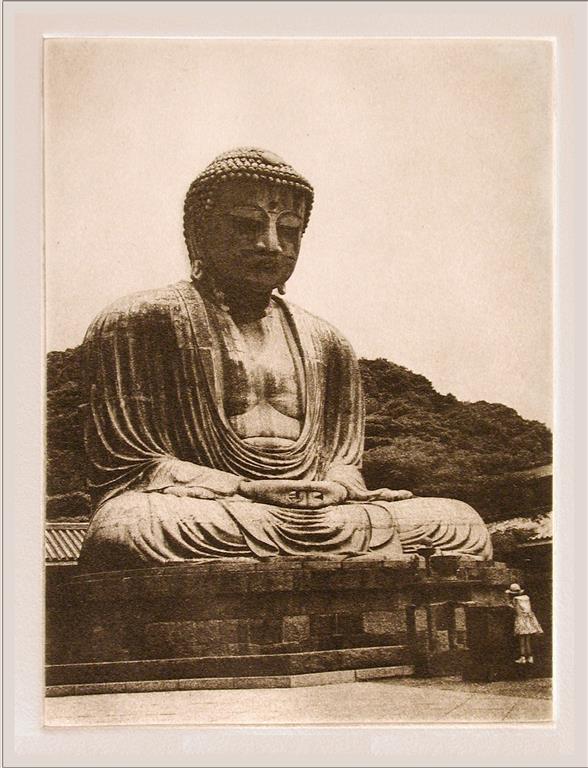

6. Daibutsu ・ 鎌倉大仏。 14 x 18 cm (6 x 7") photogravure etching, Sepia + black etching inks on 25 x 28 cm (10 x 11") Fabriano paper (1992); the Great Buddha, survivor of fires, earthquakes, and tsunamis of tourists; Kamakura, Japan; Tirage: 31.
In the United States, Daibutsu is available exclusively from Conrad Graeber.
For delivery to other countries, please click the rice image here:

On the page that follows, please enter $300 or equivalent in another currency. Your original photogravure etching will arrive at the address you write in the message space on that page.
You can also order Daibutsu with this form:
Related prints: Ryukoji
Contact | 連絡: Please type  into your email (日本語 OK).
into your email (日本語 OK).
Great Buddha of Kamakura
Survivor of fires, earthquakes, and tsunamis of tourists.
In 1495 a tidal wave swept away the wooden structure originally housing the Daibutsu; since then it has stayed imperturbably in the open air.
"The country betwixt Suruga and Edo is well inhabited. We saw many hotoke or Temples as we passed, and amongst others one Image of especiall note, called Daibutsu, made of Copper, being hollow within, but of a very substantiall thicknesse. It was in height, as wee ghessed, from the ground about one and twentie foot, in the likeness of a man kneeling upon the ground, with his buttockes resting on his heeles, his armes of wonderfull largenesse, and the whole body proportionable. He is fashioned wearing of a Gowne. This Image is much reverenced by Travellers as they passe there. Some of our people went into the bodie of it, and hoope and hallowed, which made an exceeding great noyse. We found many Characters and Markes made upon it by Passengers, whom some of my followers imitated, and made theirs in like manner."
-- John Saris, a 16th-century visitor, quoted in They Came to Japan, by Michael Cooper.
"But that which I did more admire than all the rest was a mighty idoll of bras[s], called by them Daibutsu, and standeth in a vallie betwixt 2 mountaynes, the howse being quite rotten away... This idoll is made sitting cros legged (telor lyke)... I was within the hollownes of it and it is as large as a greate howse. I doe esteem it to be bigger then that at Roads, which was taken for 1 of the 7 wonders of the world... It is thought 3000 horses would nothing neare carry away the copper of this. In fine, it is a wonderfull thinge."
-- Richard Cocks, October 18, 1616, quoted in They Came to Japan, by Michael Cooper.
Rudyard Kipling,
BUDDHA AT KAMAKURA (1892)
O Ye who tread the
Narrow Way
By Tophet-flare to
Judgement Day,
Be gentle when
"the heathen" pray
To Buddha at Kamakura!
To him the Way, the
Law, apart,
Whom Maya held beneath
her heart,
Ananda's Lord, the
Bodhisat,
The Buddha of
Kamakura.
For though he neither
burns nor sees,
Nor hears ye thank
your Deities,
Ye have not sinned
with such as these,
His children at
Kamakura;
Yet spare us still the
Western joke
When joss-sticks turn
to scented smoke
The little sins of
little folk
That worship at
Kamakura -
The grey-robed,
gay-sashed butterflies
That flit beneath the
Master's eyes.
He is beyond the
Mysteries
But loves them at
Kamakura.
And whoso will, from
Pride released,
Contemning neither
creed nor priest,
May feel the Soul of
all the East
About him at Kamakura.
Yea, every tale Ananda
heard,
Of birth as fish or
beast or bird,
While yet in lives the
Master stirred,
The warm wind brings
Kamakura.
Till drowsy eyelids
seem to see
A-flower 'neath her
golden htee
The Shwe-Dagon flare
easterly
From Burmah to
Kamakura;
And down the loaded
air there comes
The thunder of
Thibetan drums,
And droned - "Om
mane padme oms"
A world's width from
Kamakura.
Yet Brahmans rule
Benares still,
Buddha-Gaya's ruins
pit the hill,
And beef-fed zealots
threaten ill
To Buddha and
Kamakura.
A tourist-show, a
legend told,
A rusting build of
bronze and gold,
So much, and scarce so
much ye hold
The meaning of
Kamakura?
But when the morning
prayer is prayed,
Think, ere ye pass to
strife and trade,
Is God in human image
made
No nearer than
Kamakura?